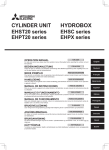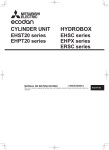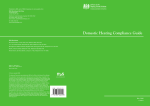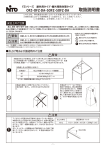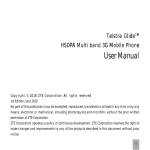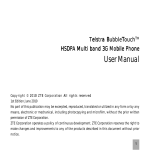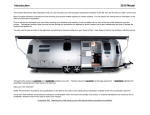Download MHS Boilers EF500 Technical data
Transcript
GEMINI HSC GUIDE TO INSTALLATION SERVICE & CLEANING L 117 GEMINI HSC Index page 2 section 3 . . . . . . . . . . .1.0 2.0 3.0 General Notes Water Supply Regulations Building Regulations 4 . . . . . . . . . . .4.0 Specification for Gemini 5 . . . . . . . . . . .5.0 . . . . . . . . . . . .6.0 Single Calorifier Dimensional Data Connection Details 6 . . . . . . . . . . .7.0 Technical Data 7 . . . . . . . . . . .8.0 . . . . . . . . . . . .9.0 Installation Requirements System Schematics 8 . . . . . . . . . . .9.0 System Schematics (Contd) 9 . . . . . . . . . .10.0 . . . . . . . . . . .10.1 Unvented Hot Water Installation Unvented Installation Component Check List 10 . . . . . . . . .10.1 Unvented Installation Component Check List (Contd) 11 . . . . . . . . .10.1 Unvented Installation Component Check List (Contd) 12 . . . . . . . . .10.2 .............. Unvented Systems Terminating Safety Discharge Pipes 13 . . . . . . . . .10.2 .............. Unvented Systems Terminating Safety Discharge Pipes (Contd) 14 . . . . . . . . .10.3 Secondary Circulation 15 . . . . . . . . .11.0 Horizontal Installation 16 . . . . . . . . .12.0 . . . . . . . . . . .13.0 Control Panel Wiring Detail 17 . . . . . . . . .14.0 Electrical Connection 18 . . . . . . . . .15.0 . . . . . . . . . . .16.0 .............. Water Connections Filling the Water Heater/ Commissioning the Water System 19 . . . . . . . . .16.0 .............. . . . . . . . . . . .17.0 Filling the Water Heater/ Commissioning the Water System (Contd) Unvented System Controls 20 . . . . . . . . .18.0 . . . . . . . . . . .19.0 . . . . . . . . . . .20.0 Optional Immersion Heaters Use of Electric Immersion Heater Draining the Calorifier 21 . . . . . . . . .21.0 Immersion Heater Replacement 22 . . . . . . . . .22.0 Internal Inspection (Secondary) 23 . . . . . . . . .23.0 .............. . . . . . . . . . . .24.0 Optional 3 Phase 7.5kW Immersion Heater for Model 500-i To Reset Limit Thermostat (All Models) GEMINI HSC 1.0 general notes The Gemini HSC range of high performance calorifiers from MHS Boilers Ltd comprises six models, the 60-i, 100-i, 150-i, 200-i, 300-i and the 500-i providing hot water outputs of up to 1474 L/hr continuous at a temperature rise of 50°C. Gemini HSC calorifiers are constructed from two concentric cylindrical tanks (tank within a tank), a principle which provides many advantages over conventional coil or tube type calorifiers. The inner or secondary tank which contains the domestic hot water, is positioned within a mild steel primary tank in which the primary heating water is circulated. This arrangement ensures that the domestic water is thoroughly, efficiently and rapidly heated to provide volume hot water for a wide variety of domestic, commercial or industrial applications. The secondary inner tank is fabricated from corrugated stainless steel and is suspended within the primary tank. The suspended and corrugated form allows the inner tank freedom to move and flex freely preventing performance reducing calcium scale from adhering to the inner walls. The corrugations also create eddy currents within the water as heating takes place preventing stratification and ensures thorough and even heating of the entire domestic volume with no cool zones. The thorough and even heating working principle of the HSC calorifier greatly assists with the prevention of legionella bacteria. The scale resistant features together with the corrosion resistance of the stainless steel significantly reduces the frequency of maintenance and avoids the need for sacrificial anodes. Each Gemini HSC is equipped with a top mounted inspection/cleaning access port and has the facility to be supplied with a backup electric immersion heater to provide nominal hot water supply during boiler shutdown. Gemini HSC calorifiers carry a five year guarantee against material or manufacturing defect in relation to the water carrying parts. All other parts have a one year guarantee. water byelaws scheme approved product The Gemini HSC calorifier is listed in the Water Regulations Advisory Scheme’s Water Fittings and Materials Directory. The Scheme’s Fittings assessment panel finds that the use of Gemini HSC fittings or units, when correctly installed, will not contravene the requirements of the Water Regulations or Regulations (NI). 2.0 water supply (water fittings) regulations 1999 The water regulations ensure a good supply of wholesome water, and that only approved materials, pipes and fittings are used to convey water. 3.0 building regulations Building regulations are statutory and take precedence over all other regulations and recommendations. The installation of a water heater into an unvented system must meet the requirements of Building Regulation G3 and may only be installed by a competent person. All installations of unvented hot water storage systems having a capacity of more than 15 litres should be notified to the relevant Local Authority by means of building notice or by the submission of full plans. Note, it is an offence to install an unvented hot water storage system without notifying the Local Authority. 3 GEMINI HSC 4.0 specification for gemini vessel The Gemini HSC calorifier is constructed from two concentric cylindrical tanks. The primary outer tank is manufactured from boiler quality ST-37 carbon steel. The domestic hot water vessel is constructed from A1S1 316 Ti stainless steel and is formed with corrugated walls, and welded using inert Argon atmosphere followed by sand blast oxide removal. connections The secondary connections are formed in stainless steel and are mounted onto a removable inspection plate which also carries the thermostat pocket. immersion heater (optional) The optional immersion heater is located in the primary water space below the secondary inner tank, ensuring complete heating, and avoids being secondary water scale fouled. insulation A high standard of insulation is afforded using high density injected rigid polyurethane foam. control panel Each calorifier is equipped with an injection moulded control panel which houses a dial type thermometer, control thermostat, immersion heater switch and electric connection terminal rail. When specified for unvented hot water application, a manual reset high limit energy cut out is also included. outer jacket The product is finished using injection moulded rigid PVC and top and base covers, with an additional removable padded vinyl jacket. wall mounted brackets Models 60-i, 100-i and 150-i are supplied complete with wall mounting brackets to allow either vertical or horizontal wall mounting. key to principle components 1 Hot drawoff (vertical installation) 2 Cold feed (vertical installation) 3 Primary flow 4 Primary return 5 Primary air vent 6 Top moulding 7 Stainless steel domestic water vessel 8 Primary vessel 9 Thermostat pocket & dip tube stay 10 Base moulding 11 Dip tube 12 Padded vinyl jacket 13 Rigid polyurethane foam insulation 14 Immersion heater (optional) Secondary return connection not shown for clarity 4 GEMINI HSC 5.0 single calorifier dimensional data B a e b 60 E 40 60 - i 100 - i 150 - i 200 - i 300 - i 500 - i c 448 B a b e A E D c A 448 d d 207 G 60 G 60 F F Fig 1. Dimensions in millimetres Model A B D E F G 60 - i 749 480 – 210 145 31 100 - i 1154 480 – 205 145 31 150 - i 983 620 – 248 164 50 200 - i 1239 620 390 247 148 34 300 - i 1724 620 875 226 146 34 500 - i 1730 770 861 283 168 54 6.0 connection details * Model Primary Flow & Return c&d 60 - i 1" BSP - F 100 - i 1" BSP - F 150 - i 1" BSP - F 200 - i 1" BSP - F 300 - i 1" BSP - F 500 - i 1 /2" BSP - F 1 DHW Feed a /4" BSP - M Secondary Return e /4" BSP - M N/A 1" BSP - M 1" BSP - M 1" BSP - M 1" BSP - M 1" BSP - M *1" BSP - M *1" BSP - M 1" BSP - M *1" BSP - M *1" BSP - M 1" BSP - M *1" BSP - M *1" BSP - M 1" BSP - M 3 3 1" BSP - M Supplied with 1 / " x 1" reducing socket to increase connection size for open vented installations. (Not required, not supplied with) (Unvented connection kits) 1 DHW Drawoff b 2 e plan view 50 20 Front a b 80 Front Fig 2. 5 GEMINI HSC 7.0 technical data HSC 60 - i 100 - i 150 - i 200 - i 300 - i 500 - i DHW Capacity L UK Gal 55 12.09 100 22.0 150 33.0 200 44.0 300 66.0 500 110.0 Primary Capacity L UK Gal 22 4.83 32 7.03 44 9.67 56 12.31 72 15.83 98 21.55 m2 ft2 0.6 6.45 1.0 10.76 1.2 12.91 1.6 17.22 2.4 25.83 3.1 33.36 17 58,000 35 119,420 33 112,596 44 150,128 67 228,604 86 293,432 Model Performance Data When Primary Flow 80ºC & Return 60ºC Performance Data When Primary Flow 85ºC & Return 65ºC Performance Data When Primary Flow 80ºC & Return 70ºC Heating Surface Heat Transfer Rate kW Btu/h Primary Circuit Pressure Drop mm, wg in wg 15 0.6 237 9.33 79 3.11 173 6.81 545 21.45 338 13.3 10min Peak Output at 50ºC ∆t L UK Gal 103 22.65 200 44.0 244 53.67 325 71.5 491 108.0 745 163.88 1st Hour Continuous L/h Output @ 50ºC ∆t UK Gal/h 346 76.11 699 153.76 715 157.28 954 209.85 1448 318.52 1974 434.22 Continuous Output at 50ºC ∆t 291 64.01 599 131.76 565 124.28 754 165.86 1148 252.52 1474 324.24 16 14 21 21 20 25 L/h UK Gal/h Heat Up Time 10-60°C min Heat Transfer Rate kW Btu/h 11.2 38,214 23.06 78,680 21.74 74,176 28.99 98,913 44.15 150,639 56.68 193,392 Primary Circuit Pressure Drop mmwg in wg 4 0.15 60 2.4 20 0.78 44 1.73 137 5.4 85 3.4 L UK Gal/h 87 19.13 165 36.49 212 46.65 282 62.21 426 93.74 661 145.60 1st Hour Continuous L/h Output at 50ºC ∆t Uk Gal/h 246 54.33 495 108.95 522 114.97 696 153.31 1056 232.48 1471 323.72 Continuous Output at 50ºC ∆t 192 42.23 395 86.95 372 81.97 496 109.32 756 166.48 971 213 24 20 31 31 30 37 10 minute peak Output at 50ºC ∆t L/h Uk Gal/h Heat Up Time 50ºC ∆t min Heat Transfer Rate kW Btu/h 8.96 30,571 18.45 62,951 17.39 59,334 23.2 79,158 35.32 120,511 45.34 154,700 Primary Circuit Pressure Drop mm wg in wg 4 0.15 60 2.4 20 0.78 44 1.73 137 5.4 85 3.4 10 min Peak Output at 50ºC ∆t L UK Gal 80 17.72 152 33.6 199 43.92 266 58.57 400 88.19 629 138.48 1st Hour Continuous L/h Output at 50ºC ∆t Uk Gal/h 208 45.88 416 91.57 448 98.57 597 131.48 905 199.18 1277 280.96 Continuous Output at 50ºC ∆t 153 33.78 316 69.57 298 65.57 397 87.48 605 133.18 777 170.97 min 30 25 39 39 37 46 Maximum Operating Temperature °C °F 90 194 90 194 90 194 90 194 90 194 90 194 Maximum Operating Pressure Primary bar psig 3.0 44 3.0 44 3.0 44 3.0 44 3.0 44 3.0 44 Maximum Operating Pressure Secondary bar psig 8.0 116 8.0 116 8.0 116 8.0 116 8.0 116 8.0 116 Kg lbs 32/109 71/241 48/180 106/397 64/258 141/569 78/334 172/737 109/481 241/1060 151/749 333/1651 Heat Up Time 50ºC ∆t Weight Empty/Filled L/h Uk Gal/h Performance of the unit may vary with other operating conditions. 6 GEMINI HSC 8.0 installation requirements The calorifiers must be installed to comply with the Water Supply (Water Fittings) Regulations 1999, Building Regulations, I.E.E. Regulations and the Bye-Laws of the local Water Company. The installation should also be in accordance with any Local Authority requirements and the recommendations of CP342 Centralised hot water supply, or BS6700 as appropriate. Gemini HSC calorifiers should be positioned on a level plinth which must be capable of supporting the weight of the calorifier when filled with water. Allowance should be made for access to the flow, return and electrical connection. 9.0 system schematics typical single calorifier open vented application Open Vent Secondary Pump IV Cold Feed IV NRV IV 3 Way Vent Valve Flow From Boiler Drain at Low Level Return to Boiler Fig 3. typical single calorifier unvented-direct-on-mains/boosted supply application Isolation Valve Expansion Relief Valve Set 6.0 bar NRV IV Temperature & Pressure Relief Valve Set 7.0 bar & 90-95°C Core Assembly with Integral Non-Return Valve Expansion Vessel Stop Valve IV Secondary Pump Pressure Limiting Valve with Integral Strainer Set 3.5 bar Flow from Boiler Balanced Pressure Cold Water Supply 3 Way Vent Valve 2 Port Spring Return Motorised Valve Tundish Cold Supply Drain at Low Level Return to Boiler Fig 4. 7 GEMINI HSC 9.0 system schematics (contd) typical multiple calorifiers open vented application Open Vent Secondary Pump IV NRV Cold Feed IV 3 Way Vent Valve Flow From Boiler IV IV Divertor Valve Reg Valve Drain at Low Level Return to Boiler Fig 5. typical multiple calorifiers unvented-direct-on-mains/boosted supply application Cold Supply Balanced Pressure Cold Water Take Off IV Stop Valve Pressure Control with Strainer Expansion Vessel Flow from Boiler Motorised Valve Expansion Valve NRV NRV Secondary Pump IV Temperature & Pressure Relief Valve IV 3 Way Vent Valve Pressure Operated Bypass Valve Tundish Note See also Fig.4. Drain at Low Level Return to Boiler Fig 6. unvented application detail of core manifold assembly Core Manifold Inc Non Return Valve Pressure Limiting Valve Set 3-5 bar Inc Strainer 8 Plugged Tapping For The Take-Off of A “Balanced Pressure” Cold Supply if Req’d. Expansion Relief Valve Set 6 bar Remove and Discard Plug. Connect Expansion Vessel To This Port Fig 7. GEMINI HSC 10.0 unvented hot water installation To install a Gemini HSC Calorifier as an unvented hot water storage package, then a Water Regulations Advisory Scheme approved kit of safety devices, valves and fittings complying with BS7206:1990 and satisfying the requirements of Building Regulation G3, available from MHS Boilers Ltd must be installed to protect the system and prevent water temperature from exceeding 100°C. The kit of parts includes as a minimum (see checklist of components 10.2), a suitably sized expansion vessel with air charge pre-set at 3.5 bar, a pressure limiting valve set at 3.5 bar, an expansion relief valve set at 6.0 bar, a temperature and pressure relief valve set at 7.0 bar and 90-95°C, a core manifold assembly with integral non return valve, a tundish and a 2 port spring return motorised valve. The components must be installed as shown in fig 4. There must be no valves installed between the calorifier and the connection to the expansion relief valve. The connections provided for the connection of the temperature and pressure relief valve and the expansion relief valve must not be used for any other purpose. The mains water supply pressure must not exceed 12.0 bar. 10.1 unvented installation component check list calorifier models 60i, 100i, 150i Component Part No. 1. 22mm pressure reducing valve with integral coaxial strainer and balanced cold water take off connection (blanked) Pre-set 3.5 bar. PRED 510 008 2. 22mm expansion/check valve assembly with integral expansion vessel connection. Relief setting 6.0 bar. CORE 215 002 3. 12 litre expansion vessel. Precharge pressure 3.5 bar. XVES 600 027 4. Expansion vessel mounting bracket c/w fixings. BRKT 240 023 5. 3 /4" aluminium braided connection hose (for expansion vessel) 1000mm long. HOSE 202 106 6. 3 /4" MI BSP Inlet/22mm relief connection temperature and pressure safety relief valve with 230mm probe set 7.0 bar and 90-95°C. PTEM 575 901 7. 22mm x 28mm acetal tundish straight. TUND 219 001 8. 1" FI BSP equal tee bronze for temperature and pressure relief valve connection to hot water draw off connection. ZTEE 250 007 9. 1" x 3/4" BSP reducing bush DZR for temperature and pressure relief valve connection to tee piece (as listed above). ZDAP 201 002 10. 1" x 3/4" BSP reducing bush DZR for connection of tee piece (as listed in 8 above) to hot water draw off connection of model 60i calorifier. Not required for models 100i, 150i and 200i. ZDAP 201 002 11. 28mm Landis two port spring return motorised valve c/w actuator. ZONE 250 401 9 GEMINI HSC 10.1 component check list (contd) calorifier model 200i Component Part No. 1. 22mm pressure reducing valve with integral coaxial strainer and balanced cold water take off connection (blanked). Pre-set 3.5 bar. PRED 510 008 2. 22mm expansion/check valve assembly with integral expansion vessel connection. Relief setting 6.0 bar. CORE 215 002 3. 18 Litre expansion vessel. Precharge pressure 3.5 bar. XVES 600 031 4. Expansion vessel mounting bracket c/w fixings. BRKT 240 023 /4" aluminium braided connection hose (for expansion vessel) 1000mm long. HOSE 202 106 /4" MI BSP inlet/22mm relief connection temperature and pressure safety relief valve with 230mm probe set. 7.0 bar and 90-95°C. PTEM 575 901 5. 3 6. 3 7. 22mm x 28mm acetal tundish straight TUND 219 001 8. 1" FI BSP equal tee bronze for temperature and pressure relief valve connection to hot water draw off connection. ZTEE 250 007 9. 1" x 3/4" BSP reducing bush DZR for temperature and pressure relief valve connection to tee piece (as listed above). ZADP 201 002 10. 1" x 3/4" BSP reducing bush DZR for connection of tee piece (as listed in 8 above) to hot water draw off connection of model 60i calorifier. Not required for models 100i, 150i and 200i. ZDAP 201 002 11. 28mm Landis two port spring return motorised valve c/w actuator ZONE 250 401 calorifier model 300i Component Part No. 1. 1" MI BSP union type press reducing valve with integral strainer. Set 3.5 bar. PRED 300 027 2. 1" FI BSP check valve core assembly with integral balanced cold water take off CORE 255 001 connection (blanked), expansion vessel connection and expansion valve connection. 3. 10 3 /4" MI BSP inlet expansion valve with 3/4" FI relief connection. Set 6.0 bar. PREL 102 018 4. 25 litre expansion vessel. Precharge pressure 3.5 bar. XVES 603 041 5. Expansion vessel mounting bracket c/w fixings. BRKT 240 024 /4" aluminium braided connection hose 1000mm long (for expansion vessel). HOSE 202 106 /4" MI BSP inlet temperature and pressure safety relief valve with 22mm relief connection. 230mm probe. Set 7.0 bar and 90-95°C. PTEM 575 901 6. 3 7. 3 GEMINI HSC 10.1 component check list (contd) calorifier model 300i (contd) Component Part No. 8. 22mm x 28mm acetal tundish straight. TUND 219 001 9. 1" FI BSP equal tee bronze for temperature and pressure relief valve connection to calorifier hot water outlet connection. ZTEE 250 007 10. 1" x 3/4" BSP reducing bush DZR for connection of temperature and pressure relief valve into tee piece (listed above). ZADP 201 002 11. 28mm Landis two port spring return motorised valve c/w actuator. ZONE 250 401 calorifier model 500i Component Part No. 1. 1" MI BSP Union type pressure reducing valve with integral strainer. Set 3.5 bar. PRED 300 027 2. 1" FI BSP check valve core assembly with integral balanced cold water take off CORE 255 001 connection (blanked), expansion vessel connection and expansion valve connection. 3. /4" MI BSP inlet expansion valve with 3/4" FI relief connection set 6.0 bar. 3 4. 40 litre expansion vessel. Precharge pressure 3.5 bar. PREL 102 018 XVES 603 046 5. 3 /4" aluminium braided connection hose (for expansion vessel) 1000mm long. HOSE 202 106 6. 3 /4" MI BSP inlet/22mm relief connection. Temperature and pressure safety relief valve. Set 7.0 bar and 90-95°C 230mm probe. PTEM 575 901 7. 22 x 28mm acetal tundish straight TUND 219 001 8. 1" FI BSP equal tee bronze for connection of temperature and pressure relief valve to calorifier hot water outlet connection. ZTEE 250 007 9. 1" x 3/4" BSP reducing bush DZR for connection of temperature and pressure relief valve to tee piece (as listed above). ZADP 201 002 10. 11/2" FI BSP Landis two port motorised valve. ZONE 250 402 11. Landis spring return actuator for motorised valve (as listed above). ZONE 250 403 11 GEMINI HSC 10.2 unvented systems- terminating safety discharge pipes suggested ways of terminating discharging pipes safely Metal discharge pipe (D1) from temperature relief valve to Tundish safety device (e.g. temperature relief valve) Tundish 500 mm Max 300 mm Min Metal discharge pipe (D2) from tundish, with continuous fall. See 10.2d i-iv. Discharge below fixed grating (10.2d ii & iii gives alternative points of discharge) Fixed grating Trapped gulley Fig 8. suggested ways of terminating discharging pipes safely Tundish Discharge above ground level Observe detail as Fig.8 above Max. 100mm Fig 9. 12 GEMINI HSC 10.2 terminating safety discharge pipes (contd) The tundish should be vertical, located in the same space as the unvented hot water storage system and be fitted as close as possible and within 500mm of the safety device (eg. the temperature relief valve) and must be away from any electrical device. The discharge pipe (D2) from the tundish should terminate in a safe place where there is no risk to persons in the vicinity of the discharge, be of metal and: a) be at least one pipe size larger than the nominal outlet size of the safety device unless its total equivalent hydraulic resistance exceeds that of a straight pipe 9m long ie: discharge pipes between 9 and 18m equivalent resistance length should be at least two sizes larger than the nominal outlet size of the safety device, between 18m and 27m at least 3 sizes larger, and so on. Bends must be taken into account in calculating the flow resistance. Refer to Table 1 and the worked example on page 14. An alternative approach for sizing discharge pipes would be to follow BS 6700: 1987 Specification for design installation, testing and maintenance of services supplying water for domestic use within buildings and their curtilages. Appendix E, section E2 table 21. b) have a vertical section of pipe at least 300mm long, below the tundish before any elbows or bends in the pipework. c) be installed with a continuous fall. d) have discharges visible at both the tundish and the final point of discharge but where this is not possible or is practically difficult there should be clear visibility at one or other of these locations. Examples of acceptable discharge arrangements are: i. ideally below a fixed grating and above the water seal in trapped gully. ii. downward discharges at low level, ie: up to 100mm above external surfaces such as car parks, hard standings, grassed areas etc. are acceptable providing that where children may play and otherwise come into contact with discharges a wire cage or similar guard is positioned to prevent contact, whilst maintaining visibility. iii. discharges at high level; eg: into a metal hopper and metal down pipe with the end of the discharge pipe clearly visible (tundish visible or not) or onto a roof capable of withstanding high temperature discharges of water and 3m from any plastics guttering system that would collect such discharges (tundish visible). iv. where a single pipe serves a number of discharges, such as in blocks of flats, the number served should be limited to not more than 6 systems so that any installation discharging can be traced reasonably easily. The single common discharge pipe should be at least one pipe size larger than the last individual discharge pipe (D2) to be connected. If unvented hot water storage systems are installed where discharges from safety devices may not be apparent ie: in dwellings occupied by blind, infirm or disabled people, consideration should be given to the installation of an electronically operated device to warn when discharge takes place. Note: The discharge will consist of scalding water and steam. Asphalt, roofing felt and non-metallic rain water goods may be damaged by such discharges. 13 GEMINI HSC 10.3 secondary circulation It is recommended that long dead legs are avoided and that a secondary circulation system is installed as shown in figures 3 - 6. If the installation is unvented then the following information regarding system water capacity is of the utmost importance. If the specific installation has a water capacity greater than can be accommodated by the (standard) expansion vessel supplied with the water heater, then additional expansion vessels must be installed. Contact MHS Boilers Ltd for advice and guidance on selection of additional expansion vessel/s. Model Standard Expansion Vessel Size Max allowable system content with standard expansion vessel Max allowable pipework length with standard expansion vessel 60i 12 litre 200 litre 227m of 28mm Tube 100i 12 litre 200 litre 162m of 28mm Tube 150i 12 litre 200 litre 81m of 28mm Tube 200i 18 litre 250 litre 81m of 28mm Tube 300i 25 litre 415 litre 186m of 28mm Tube 500i 40 litre 665 litre 267m of 28mm Tube Table 1 Sizing of copper discharge pipe "D2" for common valve outlet sizes Valve Outlet Size Minimum Size of Discharge Pipe D1* G 3/4 22mm Maximum Resistance Allowed, Expressed as a Length of Pipe (ie. No Elbow or Bends) Resistance Created by Each Elbow or Bend 28mm Up to 9m 1.0m 35mm Up to 18m 1.4m 42mm Up to 27m 1.7m Minimum Size of Discharge Pipe D2* From Tundish Worked Example The example below is G 3/4 Temperature and Pressure Relief valve with a discharge pipe (D2) having 4 no. elbows and length of 7m from the Tundish to the point of discharge. From Table 1 • Maximum resistance allowed for a straight length of 28mm copper discharge pipe (D2) from G3/4 T&P valve is 9m. • Subtract the resistance for 4 no. 28mm elbows at 1.0m each = 4.0m. • Therefore the maximum permitted length equates to 5.0m. • As 5.0m is less than the actual length of 7m therefore calculate the next largest size. • Maximum resistance allowed for a straight length of 35mm pipe (D2) from G 3/4 T&P valve equates to: 18m. • Subtract the resistance for 4 no. 35mm elbow at 1.4m each = 5.6m • Therefore the maximum permitted length equates to: 12.4m • As the actual length is 7m, a 35mm (D2) copper pipe will be satisfactory. 14 GEMINI HSC 11.0 horizontal installation All models are suitable for horizontal installation with models 60-i, 100-i & 150-i being supplied complete with wall hanging brackets. Details for wall mounting shown below. Horizontal application of models 200-i, 300-i & 500-i requires suitable cradles to be fabricated by the installer. Important Note Any Gemini HSC calorifier that is installed in the horizontal plane MUST only be connected to an open vented system. It is not permitted to install a horizontally mounted unit to an unvented hot water system. R S R P O Fig 8. Model R S O P 60 - i 231 287 200 248 100 - i 287 580 200 248 150 - i 262 458 270 326 When installing a Gemini calorifier in a horizontal plane it is necessary to reverse the cold inlet and hot outlet secondary connections. right hand horizontal installation AAV Primary Flow Hot Draw off Control Panel Recirculation Cold Feed When making a horizontal installation (r/h or l/h) the control panel must always face to the side and primary flow and return connections must always be at top dead centre and bottom dead centre respectively. Primary Return left hand horizontal installation AAV Primary Flow Hot Draw off Recirculation Control Panel Cold Feed Primary Return Important Note Where a left hand horizontal installation is to be made, then the removable inspection plate carrying the secondary connections must be rotated through 180° from its original position so that the connection marked cold water inlet is at the top. The hot water outlet must then be connected to the top connection and the cold feed to the bottom connection. Where an electric immersion heater is to be used on a L/H installation then a L/H immersion heater must be ordered (to special order). 15 GEMINI HSC 12.0 control panel A C D B E A Control Panel Fixing Point B Electrical Connection Terminal Rail C Control Panel Moulding D Thermometer E Combined Control & Limit Thermostat F Summer/Winter Switch F Summer setting gives operation via immersion heater (optional extra) if fitted. Fig 9. 13.0 wiring detail electrical connection detail all models 3 ~ 415V L1 L2 L3 Primary Divertor Valve (as required) K M2 2 Port Spring Return Motorised Valve (unvented system) N Cl os e Supply 230V 1 Phase M2 M1 G H I O pe n M1 Primary Pump (as required) K C L N 3 R2 4 5 6 7 8 9 10 11 12 13 14 15 R 1 A 2 B 3 6 5 4 TL ~ 3 7 2 1 8 4 23 6 1 5 Re Fig 10. TL ~ - - 16 Combined Control & Limit thermostat Re - Relay R/R2 - Immersion Heater Summer/Winter (Immersion Htr/Boiler) Switch C - Terminal Rail K - 3phase Contactor By others. Important Note Any auxillary component connected to the calorifier (eg. motorised valve or pump) will need to be fuse protected as appropriate when the electrical supply into the calorifier is fuse rated for immersion heater usage. GEMINI HSC 14.0 electrical connection 1 3 2 2 Fig 11. to make electrical connections Remove 4 no. fixing screws (1) retaining control panel (2). Carefully rotate control panel (2) to expose electrical connection terminal rail (3). See Fig.11. 9 4 6 6 5 3 8 7 Fig 12. Carefully cut out cable entry aperture (5) on calorifier top cover (4). Lift up top cover (4), removing first the cleaning access cover panel (9). Route appropriately sized cables (multi strand flex only) (6) through aperture (5), through cable clamp (8) and guide cables carefully down through cable tube (7) to terminate at the control panel rear. Make necessary electrical connections to terminal rail (3) See fig.12. (see also electrical connection diagram fig.10) Refit control panel (2) to calorifier using screws (1). Ensure cables (6) are routed correctly with sufficient slack to allow future easy access to rear of control panel (2) and securely retain cables under clamp (8). Refit top cover (4) and cleaning access cover panel (9). 17 GEMINI HSC 15.0 water connections primary water connections Primary flow and return connections should be made to the calorifier using appropriate sized fittings with a male BSP component that allows for disconnection of the unit. Care must be taken to ensure that connections are watertight to avoid unseen leakage and external corrosion damage to the exterior tank and to avoid water entry into electrical components. secondary water connections All of the secondary connections are located on the top of the unit and are male BSP threaded stainless steel.* Connections should be made via fittings that do not allow galvanic corrosion between the calorifier and the system pipework. Connections to the unit must allow for complete disconnection and removal of local pipework in order that the removal of the inspection access port cover is not impeded. * Models 200-i, 300-i and 500-i when being installed on a vented system are supplied with 2no. 11/2" x 1” BSP FF reducing sockets which then creates 11/2" BSP female cold feed and hot draw off connections. 16.0 filling the water heater/ commissioning the water system It is important to ensure that all pipework is flushed to avoid the damage that foreign particles could do to control valves, this is particularly important where the installation is unvented. 1. Ensure the calorifier is correctly connected to the primary and secondary circuits. 2. The secondary (domestic) inner tank must be filled first. 3. Open all outlet taps. 4. Turn on water supply and allow the calorifier to fill. 5. Close taps in turn after having purged the system of air. 6. Check for water leaks around the appliance and in particular around any valves or controls. Check again when the appliance is hot. 7. Check that no water is passing to waste through any relief valves. 8. Test the operation of any temperature and pressure relief and expansion valves by lifting/turning the manually operated test lever/cap and observing that water flows freely and safely to waste. 9. Check that the discharge pipe is installed so that it falls continuously and that no taps, valves or other shut off devices are installed in the pipe. 18 GEMINI HSC 16.0 filling the water heater etc. (contd) 10. Fill the primary side (outer tank) and ensure correct and proper venting via the primary air (manual) air vent located adjacent to the primary flow in connection. Note: failure to properly vent the primary side of the calorifier will result in circulation noise and poor performance of the unit. IMPORTANT OBSERVATIONS Failure to observe the correct sequence of filling (ie. domestic first) may lead to irrepairable damage to the calorifier. 11. Demonstrate operation to the user including the purpose and operation of any temperature and pressure relief valve or expansion valve and what to do if these valves should self operate. 12. Hand over this manual to the user for future reference and advise that periodic checks of the equipment are essential for safety. Advise that any expansion vessel in an unvented application may need to be recharged periodically by the installer. 17.0 unvented system controls Periodic checks must include: a) Check and clean the line strainer. b) Check pressure in expansion vessel and top up as necessary. Must be set 3.5 bar. Check should be carried out with expansion vessel drained of water to avoid that you cross-read system water pressure. c) Check manually by lifting the test lever on the temperature and pressure relief valve. d) Check manually by turning the test knob on the expansion relief valve. e) Check discharge pipes from both relief valves to ensure no obstructions. 19 GEMINI HSC 18.0 optional immersion heaters Each Gemini HSC Calorifier can be fitted with an optional immersion heater. The heater element is installed into the primary tank underneath the domestic stainless steel vessel. This ensures thorough heatup of the domestic water and avoids scale build up on the element. The immersion heater will provide a nominal supply of hot water during boiler shutdown. Model Immersion Heater Rating kW Recovery Time ∆t 50°C 60 - i 1.5 3.0 hrs 100 - i 2.2 3.5 hrs 150 - i 2.2 5.2 hrs 200 - i 2.5 6.0 hrs 300 - i 2.5 8.7 hrs 500 - i 2.5 14.0 hrs 19.0 use of electric immersion heater 1. Ensure that the electrical connections have been correctly made and that the supply is of adequate rating and adequate fuse protection. 2. Ensure that the secondary and primary systems have been filled correctly, see section 16. Note: Failure to fill the primary side (outer tank) will result in “burn out” of the immersion heater element as it is located in the primary water space. 3. Set the control thermostat to the required setting. 4. Set the summer/winter switch to the summer position. 5. Turn on external electricity supply isolator. 20.0 draining the calorifier If it is required to drain the secondary (domestic) water from the calorifier then the following procedure must be followed to avoid damage to the unit. 1. Isolate and drain the primary side ensuring the manual primary air vent (located adjacent to the primary flow in connection) is opened whilst draining. 2. Isolate the domestic cold feed and open the hot draw off to atmosphere. 3. Open the low level drain leg drain cock (by installer) and the inner tank will self siphon drain. 4. For refilling, close drain cocks and vents etc and follow procedure in section 16. 20 GEMINI HSC 21.0 immersion heater replacement Fig 13. In order to replace the electric immersion heater it is necessary to drain the primary side only, see section 20.1. 1. Electrically isolate the calorifier. 2. Remove immersion heater cover panel models 200-i, 300-i and 500-i or control panel models 60-i, 100-i and 150-i. 3. Disconnect electrical connections from immersion heater (note: some models have additional manual reset high limit stat - not shown). 4. Remove fixing bolts from circumference of immersion heater carrier plate and retain bolts for re-use. 5. Remove immersion heater by withdrawing to the front and then to the side. 6. Remove and discard gasket. 7. Insert new immersion heater complete with new gasket. 8. Secure immersion heater by tightening bolts evenly using opposite-opposite sequence. 9. Refill and vent primary side - see 16.10 and ensure water tightness. 10. Reconnect electrical connections and refit cover/control panel. 21 GEMINI HSC 22.0 internal inspection (secondary) The Gemini HSC i range of calorifiers is designed to allow internal inspection/cleaning access. Fig 14. 10 Fig 15. 11 4 Fig 16. To gain access for internal inspection: 1. Isolate and drain the calorifier as described on in section 20. 2. Disconnect all secondary pipework, stripping away sections of pipework as necessary to allow full access for removal of tube plate and dip tube assembly (10) fig.15. 3. Lift up and then move to one side the plastic top moulding (4) fig 16. 4. Carefully withdraw instrument capillaries and bulbs (11) from pocket in tube plate. 5. Remove bolts from circumference of inspection cover flange plate and lift away flange plate fig.16. 6. Carefully lift away tube plate and dip tube assembly. 7. Reassembly is reverse of the above process. 8. Refill the calorifier observing procedure described in section 16. 22 GEMINI HSC 23.0 optional 3 phase 7.5kW Immersion heater for model 500-i As a factory fitted option, a 7.5kW 3phase, 415V immersion heater is available to provide enhanced electrically heated operation for the model 500i. Note: this option is not available on models 60-i, 100-i, 150-i, 200-i or 300-i. Immersion heater rating . . . . . . . . . . . . .7500W 3 phase 415V Recovery time at 50°C ∆t . . . . . . . . . . .4.7hrs 24.0 to reset limit thermostat (all models) 1. Electrically isolate the calorifier. 2. Remove control panel (see page 17 fig.11). 3. Remove thermostat knob by pulling off from control thermostat spindle. 4. Remove thermostat fixing screws and allow thermostat to move away from inside face of control panel. 5. Press reset pin marked “S” on thermostat body (adjacent to control spindle). 6. Reassemble control panel using reverse of the above procedure. 23 GEMINI HSC QW/11/00 A member of the Modular Heating Group Plc 35 Nobel Square, Burnt Mills Industrial Estate, Basildon, Essex SS13 1LT Tel: 01268 591010 Fax: 01268 728202 http://www.modular-heating-group.co.uk This publication is issued subject to alteration or withdrawal without notice. The illustrations and specifications are not binding in detail. All offers and sales are subject to the Company's current terms and conditions of sale.
























